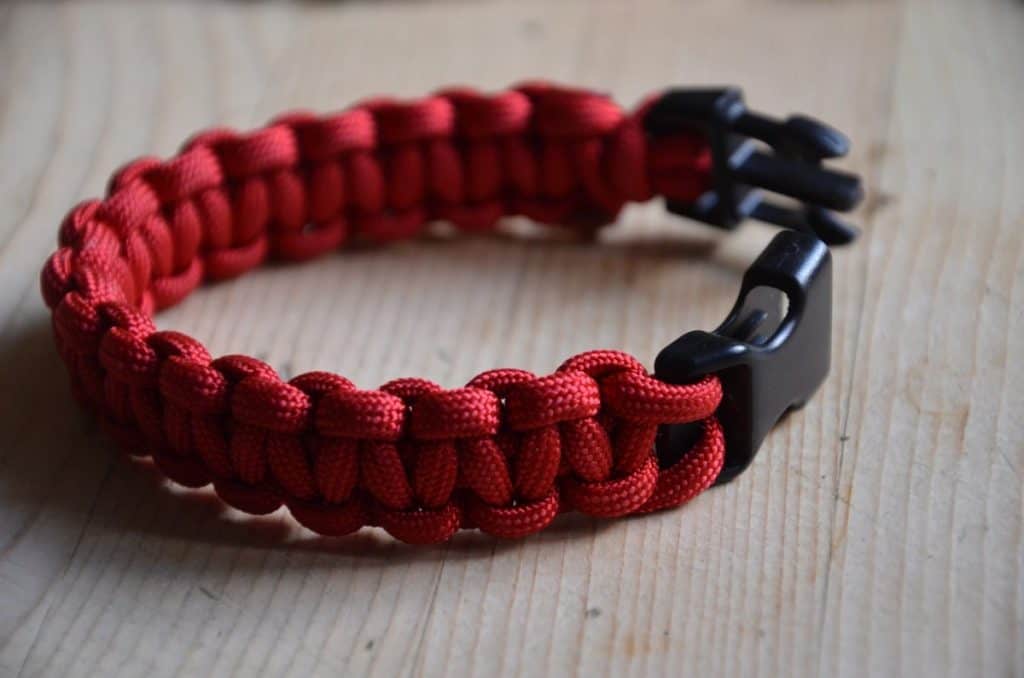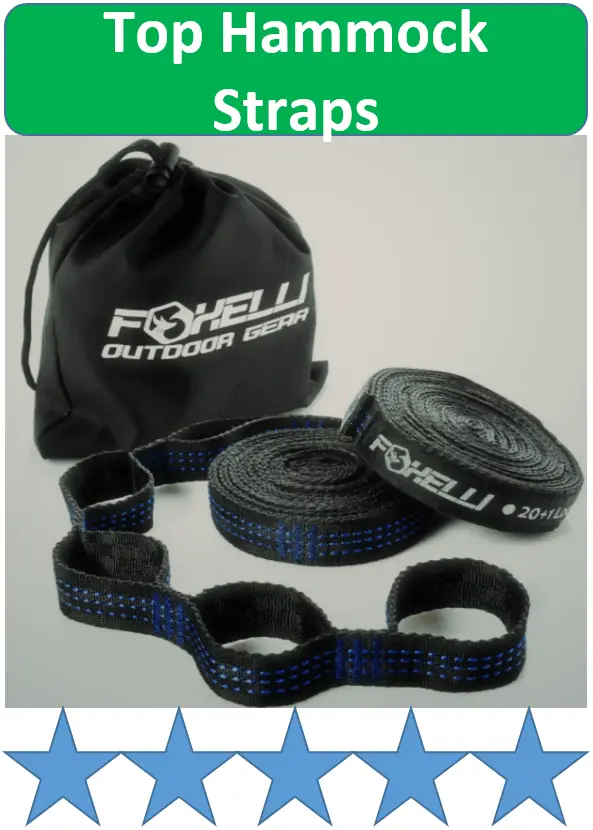One of the common misconceptions we run into a lot is how the weight standards work with parachute cord (paracord). This leads to questions like “Can 550 paracord hold 550 lbs in a camping hammock?”
The short answer is maybe for a short time, but you’re living on borrowed time at that point.
550 paracord can handle 550 lbs of stress. This means it can hold 550 lbs when there is zero pressure or movement adding stress. However a 150 person can create 1,000 lbs of force from jumping or bouncing, so paracord should never be used for life and death situations like climbing, and is impractical for extended use like with hammocks.
Not understanding the difference between the weight the paracord is set for as a breaking point versus practical use is a major problem with paracord.

While it’s still a create crafting or survival tool from the standpoint that it’s versatile and can give you a lot of rope to work with carried in a small space, paracord is nowhere close to being interchangeable with actual rope.
Why Paracord Won’t Work for Hammock Camping
Many people want to know if paracord will work for hammock camping. The short answer is no. Even when you’re enjoying your time in a hammock, how often do you keep 100% still?
Any movement (no matter how small), any breeze, any shift puts way more pressure on the paracord than the amount of weight it’s holding. You also likely only have a couple strands (at most) on both sides, which means even if you get it to the point where nothing’s likely to snap, you only need one to break to add that pressure and start a domino effect.
Using 550 paracord on a hammock simply isn’t practical. Neither is any other type of paracord compared to ropes (which hurt trees and shouldn’t be used if you can help it) or hammock straps (best choice).
If you absolutely have no other choice, and cowboy camping isn’t an option (or you see that as a last resort) then at least try to go with 750 paracord as opposed to the 550. This at least gives you a much better chance of at least a temporary decent sleep.
Paracord Facts to Remember
- The 550 is the tensile strength
- Stretches under heavy loads well below this weight
- Meant for short term use, not steady hanging pressure
- Relatively low strength
- Will shrink when exposed to heat and moisture, changing stretchiness as well as overall real world strength
Paracord Is Too Stretchy to Hold Camping Hammocks
Paracord was designed to give support and stretch while someone is opening a parachute. This means extreme effectiveness during one single important point.
And the elastic ability to stretch was just as important as the ability to hold. In some ways more so, as more strands could be added to support the weight but if there wasn’t enough stretch you could badly injure or cripple every person who used it.
So paracord was never designed for practical long-term use where steady pressure is put on the paracord.
Paracord can be made out of nylon, polyester, or both. These materials stretch. Not only that, but they are considered “high memory” in their stretch.
What does this mean?
If tested even with small amounts of wait for extended periods of time, the paracord can stretch in length, A LOT. This forum study shows this, and I’ve confirmed it in the past (confirmation video repeat of this experiment to come in the near future).
The paracord stretches out a lot, and permanently to some extent. If you’re starting in a hammock only a couple feet of the ground, you will likely find your butt on the cold hard ground before midnight.
Paracord Is Too Thin/Weak to Hold Camping Hammocks
The number of times I watched a newbie confidently brag about the knots they tied using two strands with paracord, then did a “jump” into the camping hammock that promptly landed their ass all the way on the ground or even snapped the paracord in half.
It never gets old.
Really, it’s ALWAYS funny.
These are designed to be thin and stretchy for a sudden one time use in support with other strands of paracord. They’re not designed to take a steady load of pressure at or near their break point, or even dramatically under.
Hammock suspension systems generally run by a rule of needing 1 inch or more as a suspension system. Paracord is 3/16 of an inch when relaxed and 1/8 of an inch when stretched tight.
That is way, way below accepted standards for what works.
Paracord isn’t designed to be used this way. While 550 paracord, if you use enough, might hold an adult for the short-term, it’s like sleeping on egg shells and it won’t be a comfortable sleep nor is it viable over the long-term.
Paracord Isn’t Built for Long-Term Resilience
Remember that term “one-time use” that has been thrown around this post multiple times. There’s a reason for that.
Paracord is designed for short-term use, to be able to pair up or be used with multiple strands to spread out the sudden shock of a drop. But that 550 lbs is not a “550 lbs in the real world” setting.
If a 150 pound guy jumps on a hammock? That’s probably 1,000 lbs of force. 200 pound guy swinging back and forth? That could be 600 or 700 lbs of force. Shifting to get more comfortable? Even a small shift by someone 300 lbs could shoot the pressure up to 600 lbs.
In other words, that 550 paracord is deceptive if you don’t understand how the measurement of force vs. actual resting weight works.
Just trust me on this: paracord is not build for long-term resilience.
Even in a survival situation it’s best use is often for tight lashings or knots, like for creating a shelter. Not for making tools and NEVER use paracord as climbing rope.
Remember What Paracord Was Designed For
The rating was pressure before the cord would snapped. Paracord was used for paratroopers so it needed to be stretchy (so they didn’t snap their spines when the chute stopped them from a free fall) while still holding an impressive amount of weight.
But no parachute is held by one or two strands of paracord. Parachutes had 8, 10, 12 strands. More if equipment was being parachuted in with the troops.
In other words 8 * 550 = 4,400 lbs of pressure.
Follow the logic, not the math
Yes, I realize the science and math doesn’t technically work like that in real life, but this is about understanding the concept, not the exact numbers. Pressure was dispersed. The number needed for a troop and gear topping scales at 200 lbs was way, WAY above the numbers shown.
Because this is about breaking point and tensile strength, not actual “practical” measurement in everyday use.
Look, I love going the MacGyver route of making something work, I love outdoor creativity, and I love versatile gear that can serve many purposes in a live or die emergency situation out in the wild.
Best Option for Camping Hammocks: Hammock Straps
If you’re hammock camping I know it can still be tempting to use the $10 paracord to see if you can save money from buying hammock straps…but you can get really good hammock straps for surprisingly cheap.
And good hammock straps you can use over and over again.
So what hammock straps should you buy?
My Recommendation: Foxelli Hammock Straps
Just to be 100% clear: there are many, many great hammock strap options out there. So if you’re a huge fan of Wise Owl or ENO, go for it. You’re not going to do badly with any widely recognized hammock straps that have thousands of positive online reviews.
So at that point it’s preference, ease of use, and weighing cost and simplicity vs. quality of use. While there are many options I really like Foxelli. Mine still hold up, I know a lot of people who have used these, and there are virtually no complaints

I give this one five stars for a reason. They’re reliable and they will beat the living heck out of any 550 paracord camping hammock setup.
In Conclusion
While you technically can set up a hammock with 550 paracord, unless there is nothing else on hand and this is just a short term fix then you really shouldn’t.
If you hammock camp a lot, buy the hammock straps. If you’re hiking through weeks of desert, go with a pup tent. While this might not be what you hoped to hear, trust me. From personal experience testing out all of these situations, you don’t want to go with paracord to hang a hammock.
While in theory it sounds great, in practice it just doesn’t work that well.
